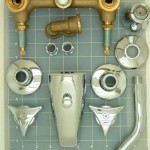How Much Does It Cost To Replace A Bathtub With A Walk-In Shower?
Replacing a bathtub with a walk-in shower is a common home renovation project driven by factors such as accessibility concerns, aesthetic preferences, and space optimization. Determining the cost of such a project involves considering several variables that can significantly affect the overall budget. This article provides an in-depth analysis of the factors influencing the cost of converting a bathtub into a walk-in shower.
Factors Influencing the Cost
The total cost of replacing a bathtub with a walk-in shower is not a fixed number. It is influenced by a combination of factors related to the shower design, materials, labor, and potential unforeseen issues. A thorough understanding of these factors is crucial for accurate budgeting and informed decision-making.
Shower Size and Configuration: The dimensions of the intended walk-in shower play a significant role in determining the cost. Larger showers generally require more materials, such as tiling, shower doors, and plumbing adjustments. The configuration, whether it’s a standard rectangular shape or a more complex custom design, also affects material usage and labor hours. A simple, standard-sized shower will naturally be less expensive than a large, uniquely shaped one.
Materials: The price of materials constitutes a substantial portion of the overall budget. The choice of tiling is a major cost driver. Ceramic tiles are typically the most affordable option, while porcelain, glass, and natural stone tiles are significantly more expensive. Other material choices include the shower base, shower doors or curtains, plumbing fixtures (showerhead, faucet, drain), and any waterproofing materials. The quality and brand of these materials will directly impact the price.
Labor Costs: Labor costs vary based on the complexity of the project and the geographic location. Hiring a licensed and experienced contractor ensures quality workmanship and adherence to local building codes, but it also comes at a higher price. The labor component typically includes demolition of the bathtub, plumbing adjustments, framing (if necessary), tiling, shower door installation, and finishing work. More intricate designs or significant plumbing changes will necessitate more labor hours, increasing the overall cost.
Plumbing Adjustments: Replacing a bathtub with a walk-in shower often requires modifications to the existing plumbing. The location of the drain and water supply lines may need to be altered to accommodate the new shower configuration. If the existing plumbing is outdated or in poor condition, it may be necessary to replace it entirely. These plumbing adjustments can add significantly to the total cost, especially if the work involves moving drain lines or replacing corroded pipes.
Accessibility Features: Many homeowners choose to incorporate accessibility features into their walk-in showers, such as grab bars, built-in seating, and curbless entries. These features enhance safety and convenience, particularly for individuals with mobility limitations. However, the inclusion of accessibility features also increases the cost. Grab bars range in price depending on the material and finish, while built-in seating requires additional framing and tiling. Curbless entries often necessitate more complex floor leveling to ensure proper drainage.
Shower Door/Enclosure: The type of shower door or enclosure significantly impacts the overall cost. Options range from simple shower curtains to sliding glass doors, hinged glass doors, and custom-built enclosures. Shower curtains are the most economical choice, while glass doors offer a more sophisticated look and better water containment. The price of glass doors depends on the thickness of the glass, the type of frame (framed or frameless), and the complexity of the design. Custom-built enclosures are the most expensive option, as they require precise measurements and specialized installation.
Permits and Inspections: Depending on local regulations, a permit may be required for replacing a bathtub with a walk-in shower. Obtaining a permit involves submitting plans to the local building department and paying a fee. Inspections are typically required at various stages of the project to ensure compliance with building codes. Failing to obtain the necessary permits can result in fines and delays, so it is essential to factor these costs into the overall budget.
Demolition and Disposal: The demolition of the existing bathtub and the disposal of debris also contribute to the overall cost. This process involves removing the old bathtub, disconnecting plumbing, and hauling away the debris. Some contractors include demolition and disposal in their overall estimate, while others charge separately. The cost of demolition and disposal can vary depending on the size and weight of the bathtub, as well as local disposal fees.
Cost Breakdown and Potential Price Ranges
Providing an exact cost for replacing a bathtub with a walk-in shower is difficult without specific details about the project. However, it is possible to provide a general cost breakdown and potential price ranges based on the factors discussed above.
Basic Conversion (Minimal Changes): A basic conversion involves replacing the bathtub with a standard-sized walk-in shower with minimal alterations. This typically includes replacing the bathtub with a pre-fabricated shower base, installing basic tiling (e.g., ceramic), and using a shower curtain or a simple sliding glass door. Plumbing adjustments are minimal. The cost for a basic conversion can range from $3,000 to $6,000.
Mid-Range Conversion (Moderate Changes): A mid-range conversion involves a more comprehensive renovation with moderate design changes. This may include custom tiling (e.g., porcelain or glass), upgrading the shower enclosure to a hinged glass door, and making some plumbing adjustments. Accessibility features such as grab bars may also be included. The cost for a mid-range conversion can range from $6,000 to $12,000.
High-End Conversion (Extensive Changes): A high-end conversion involves a complete renovation with extensive design changes and high-quality materials. This may include a custom-built shower enclosure, high-end tiling (e.g., natural stone), significant plumbing modifications, and the incorporation of multiple accessibility features (e.g., curbless entry, built-in seating). The cost for a high-end conversion can range from $12,000 to $20,000 or more.
Specific Cost Examples:
- Demolition and Disposal: $200 - $500
- Plumbing Adjustments: $500 - $1,500
- Framing (if necessary): $300 - $800
- Tiling (materials and labor): $1,000 - $5,000+ (depending on tile type and area)
- Shower Base: $300 - $1,000 (pre-fabricated) or more for custom
- Shower Door/Enclosure: $200 (curtain) - $3,000+ (custom glass enclosure)
- Grab Bars: $50 - $200 per bar
- Built-in Seating: $500 - $1,500
- Permit Fees: $50 - $500 (depending on locality)
These are just estimates, and the actual cost may vary depending on the specific circumstances of each project.
Strategies for Controlling Costs
While replacing a bathtub with a walk-in shower can be a significant investment, there are several strategies that homeowners can employ to control costs without compromising the quality of the renovation. Careful planning, material selection, and contractor negotiation can all contribute to a more budget-friendly project.
Obtain Multiple Quotes: It is essential to obtain quotes from multiple contractors before making a decision. This allows homeowners to compare prices, services, and reputations. Be sure to ask for a detailed breakdown of the costs, including materials, labor, permits, and any other fees. Comparing quotes from different contractors can help identify the best value for the project.
Choose Cost-Effective Materials: Selecting cost-effective materials can significantly reduce the overall budget. For example, opting for ceramic tiles instead of natural stone can save hundreds or even thousands of dollars. Similarly, choosing a simple shower curtain or a basic sliding glass door instead of a custom-built enclosure can also lower costs. However, it is important to balance cost-effectiveness with quality and durability.
Minimize Plumbing Adjustments: Plumbing adjustments can be a major cost driver in this type of renovation. To minimize these costs, try to design the walk-in shower in a way that minimizes the need for plumbing modifications. For example, positioning the shower drain in a similar location to the existing bathtub drain can reduce the amount of plumbing work required.
Consider DIY Options (With Caution): Some homeowners may be tempted to handle certain aspects of the renovation themselves to save money on labor costs. While DIY projects can be a viable option for experienced homeowners, it is important to proceed with caution. Improper installation can lead to costly repairs and potentially compromise the safety of the bathroom. Complex tasks such as plumbing and electrical work should always be left to qualified professionals.
Plan Ahead and Avoid Changes: Changes during the renovation process can quickly escalate costs. To avoid this, it is important to plan ahead and make all design decisions before the project begins. Ensure that you have a clear vision of the desired outcome and communicate it effectively to the contractor. Any changes made after the work has started can result in additional labor and material costs.
Look for Sales and Discounts: Retailers often offer sales and discounts on bathroom fixtures and materials. Taking advantage of these promotions can help reduce the overall cost of the renovation. It is also worth checking for clearance items or refurbished products, which can offer significant savings.
Finance Options: Explore financing options if the cost is a concern. Home equity loans or lines of credit can provide funds needed for the renovation. Also, some contractors offer payment plans to ease the financial burden.
By understanding these factors and implementing effective cost-control strategies, homeowners can make informed decisions and achieve their goal of replacing a bathtub with a walk-in shower within a reasonable budget. It is important to prioritize quality and safety while seeking cost-effective solutions to ensure a successful and satisfying renovation project.

How Much Does A Tub To Shower Conversion Cost 2025 Angi

Cost To Convert A Tub Into Walk In Shower Apartment Geeks

2025 Tub To Shower Conversion Cost Walk In Stall

How Much Does A Shower Remodel Cost In 2024 Planner 5d

Mom Knows Best The Cost Of Converting A Bathtub To Walk In Shower

How Much Does Bathtub Replacement Cost 2025 Data Angi

Cost To Convert A Tub Into Walk In Shower Apartment Geeks

Shower Remodel Cost 2025 Calculator Ranges

2025 Bathtub Replacement Cost New Tub Installation

Replace Bath With Walk In Shower Cost Installation Guide
Related Posts








